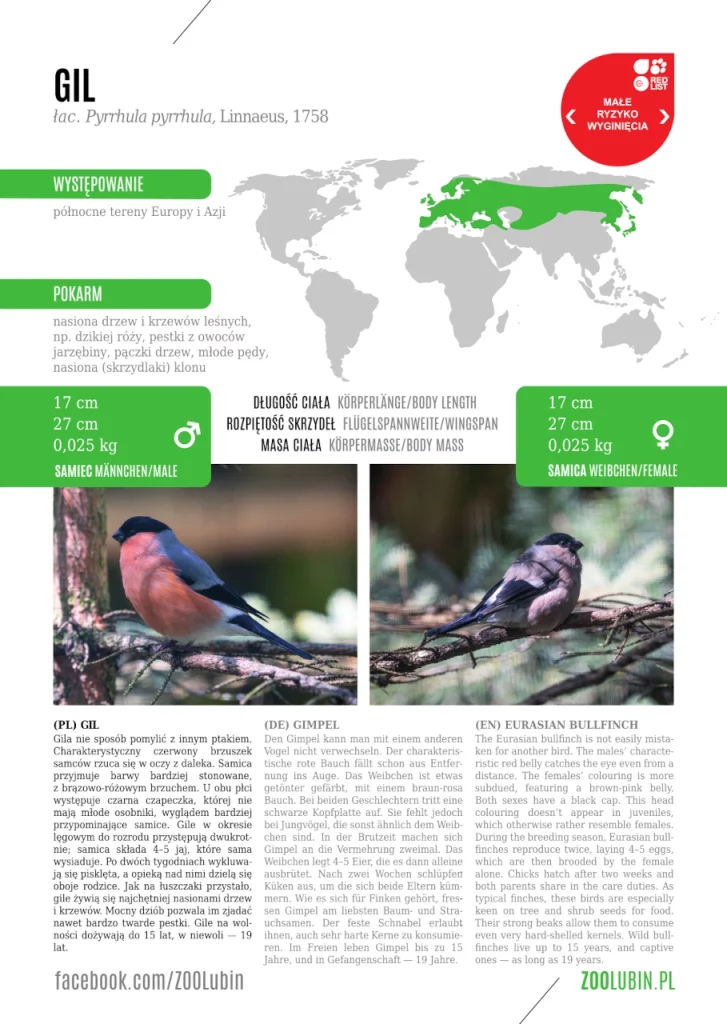
POBIERZ ETYKIETĘ GATUNKOWĄ – PLIK PDF (rozmiar 2024 KB)
Gil (PL)
łac. Pyrrhula pyrrhula, Linnaeus, 1758
Gila nie sposób pomylić z innym ptakiem. Charakterystyczny czerwony brzuszek samców rzuca się w oczy z daleka. Samica przyjmuje barwy bardziej stonowane, z brązowo-różowym brzuchem. U obu płci występuje czarna czapeczka, której nie mają młode osobniki, wyglądem bardziej przypominające samice. Gile w okresie lęgowym do rozrodu przystępują dwukrotnie; samica składa 4–5 jaj, które sama wysiaduje. Po dwóch tygodniach wykluwają się pisklęta, a opieką nad nimi dzielą się oboje rodzice. Jak na łuszczaki przystało, gile żywią się najchętniej nasionami drzew i krzewów. Mocny dziób pozwala im zjadać nawet bardzo twarde pestki. Gile na wolności dożywają do 15 lat, w niewoli ‒ 19 lat.
Występowanie: północne tereny Europy i Azji
samiec / samica
Długość ciała: ok. 17 cm
Rozpiętość skrzydeł: ok. 27 cm
Masa ciała: ok. 0,025 kg
Gimpel (DE)
łac. Pyrrhula pyrrhula, Linnaeus, 1758
Den Gimpel kann man mit einem anderen Vogel nicht verwechseln. Der charakteristische rote Bauch fällt schon aus Entfernung ins Auge. Das Weibchen ist etwas getönter gefärbt, mit einem braun-rosa Bauch. Bei beiden Geschlechtern tritt eine schwarze Kopfplatte auf. Sie fehlt jedoch bei Jungvögel, die sonst ähnlich dem Weibchen sind. In der Brutzeit machen sich Gimpel an die Vermehrung zweimal. Das Weibchen legt 4–5 Eier, die es dann alleine ausbrütet. Nach zwei Wochen schlüpfen Küken aus, um die sich beide Eltern kümmern. Wie es sich für Finken gehört, fressen Gimpel am liebsten Baum- und Strauchsamen. Der feste Schnabel erlaubt ihnen, auch sehr harte Kerne zu konsumieren. Im Freien leben Gimpel bis zu 15 Jahre, und in Gefangenschaft ‒ 19 Jahre.
Vorkommen: nördliche Gebiete Europas und Asiens
Männchen / Weibchen
Körperlänge: ca. 17 cm
Flügelspannweite: ca. 27 cm
Körpermasse: ca. 0.025 kg
Eurasian bullfinch (EN)
łac. Pyrrhula pyrrhula, Linnaeus, 1758
The Eurasian bullfinch is not easily mistaken for another bird. The males’ characteristic red belly catches the eye even from a distance. The females’ colouring is more subdued, featuring a brown-pink belly. Both sexes have a black cap. This head colouring doesn’t appear in juveniles, which otherwise rather resemble females. During the breeding season, Eurasian bullfinches reproduce twice, laying 4–5 eggs, which are then brooded by the female alone. Chicks hatch after two weeks and both parents share in the care duties. As typical finches, these birds are especially keen on tree and shrub seeds for food. Their strong beaks allow them to consume even very hard-shelled kernels. Wild bullfinches live up to 15 years, and captive ones ‒ as long as 19 years.
Distribution: northern parts of Europe and Asia
male / female
body length: ca. 17 cm
wingspan: ca. 27 cm
body mass: ca. 0,025 kg
